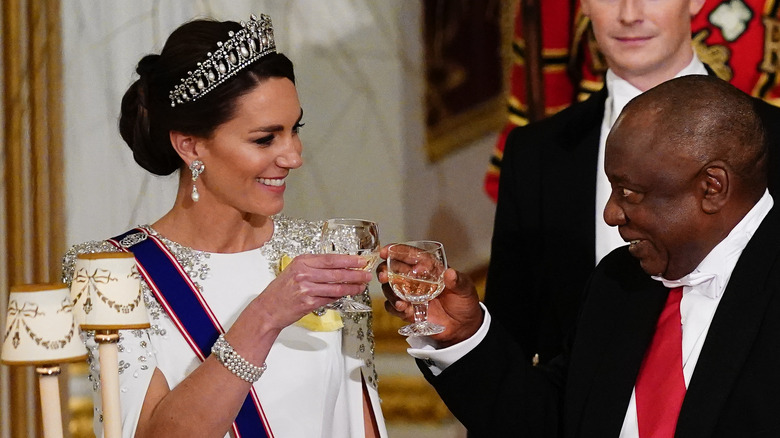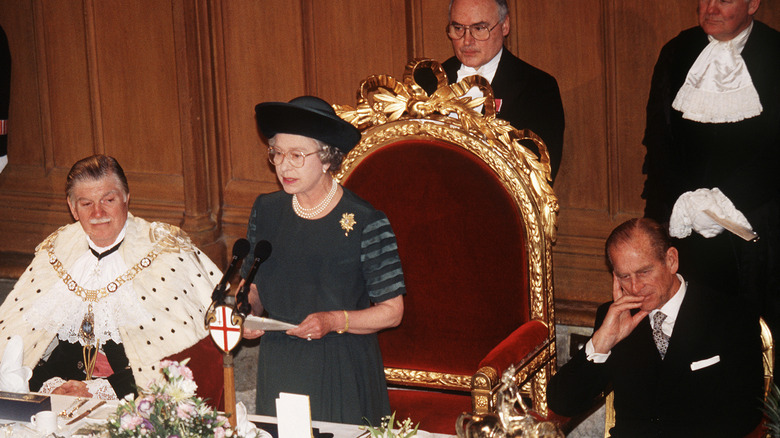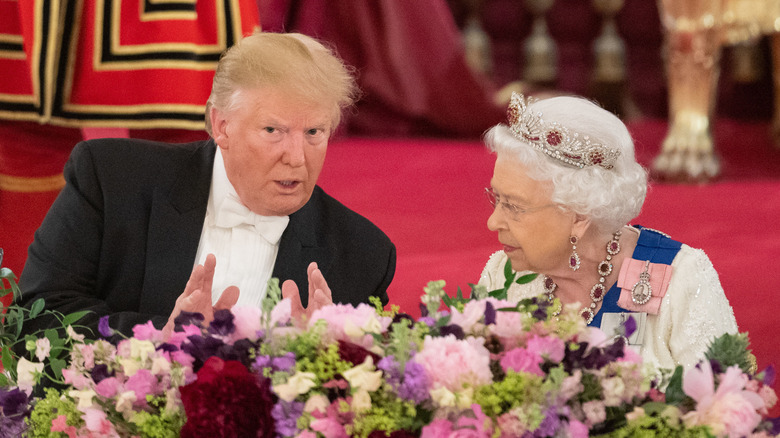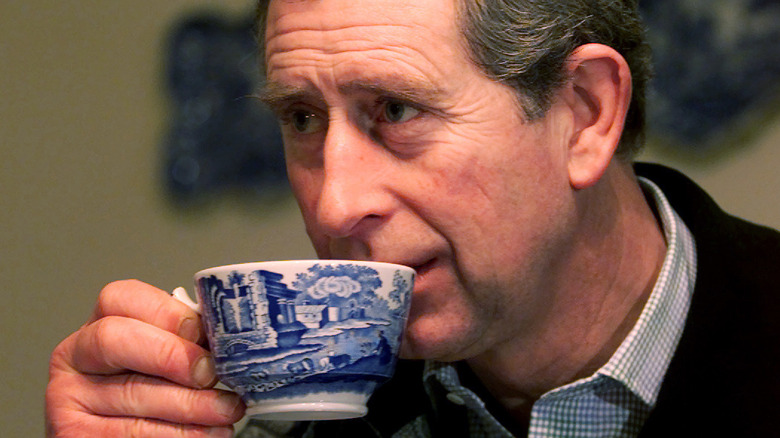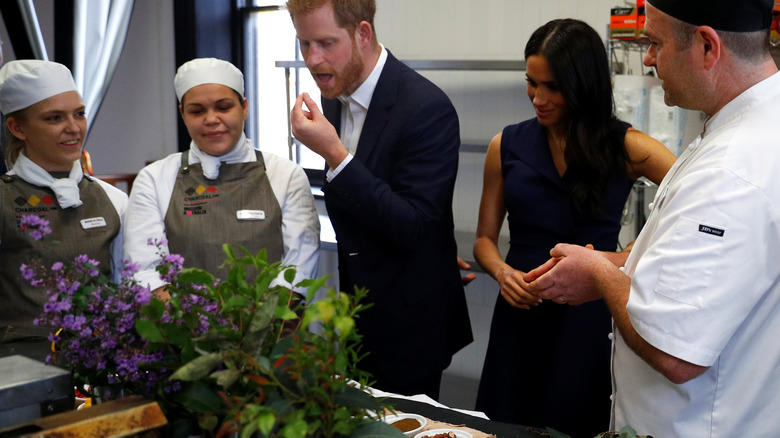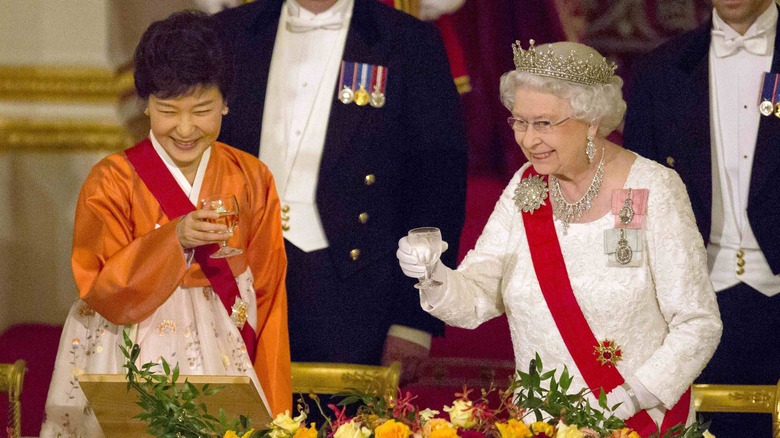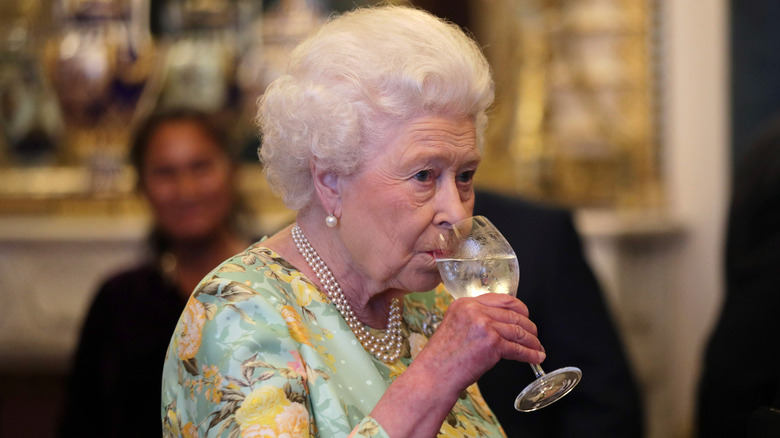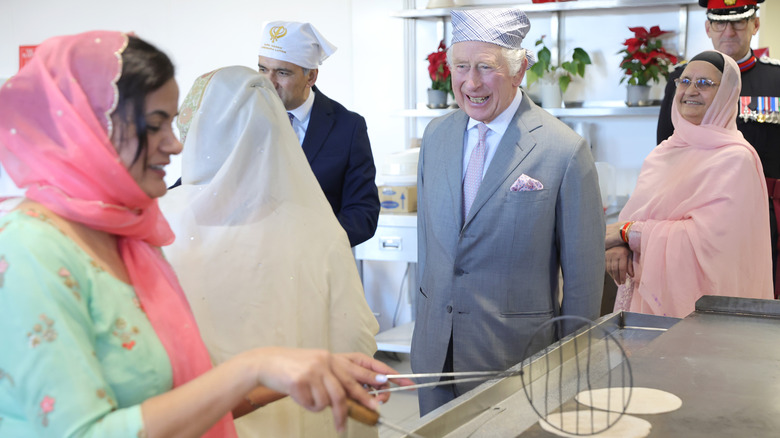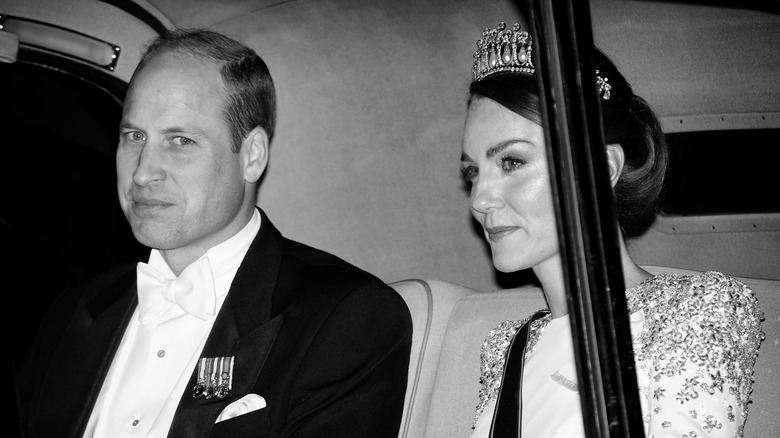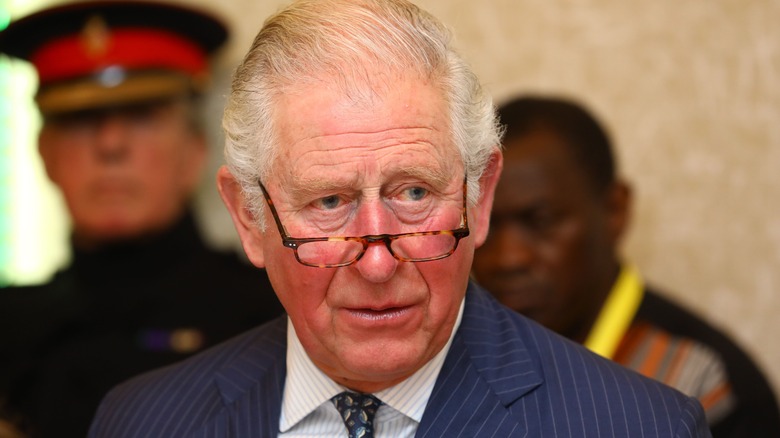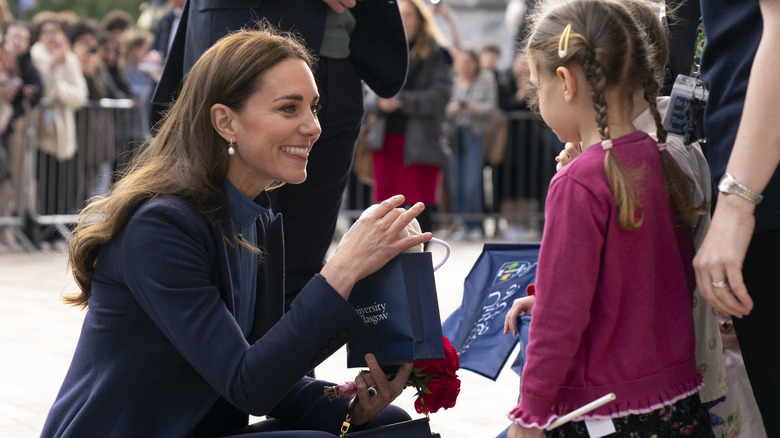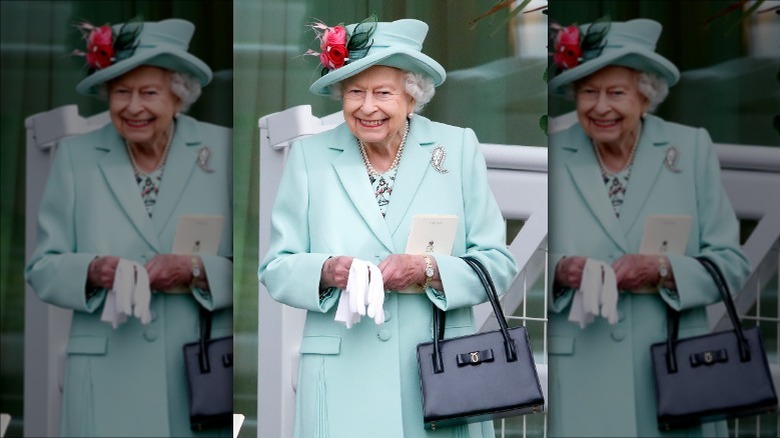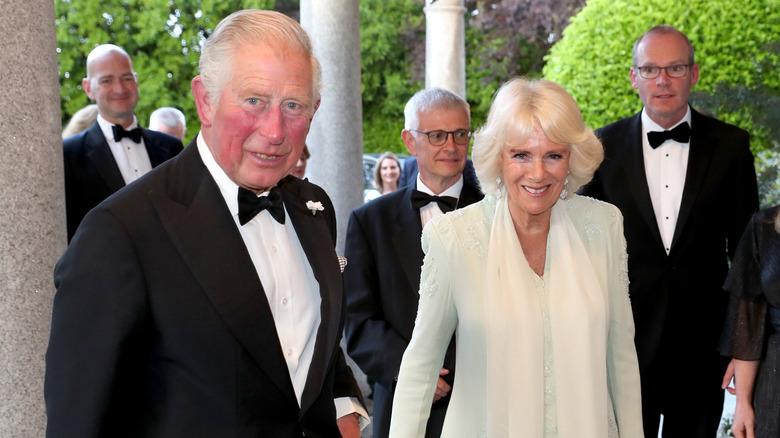Weird Food Rules The Royals Have To Follow
Being part of the British royal family may seem like a dream come true. But while the position comes with privilege, it also comes with many expectations, and the royals are under constant scrutiny to uphold those standards. Because the spotlight is always on them, members of the royal family follow strict guidelines for how to act properly. The monarchy is a long-standing tradition steeped in history, so while some things change, there are many customs and standards of etiquette that remain intact. There are rules for how they dress, how they conduct themselves in public, and even how they eat.
Although a royal banquet may be glamorous and exciting, there's plenty to consider besides enjoying the food. There are rules about everything from what they eat, who they speak to, and how to hold their utensils, which are all outlined for the royal family. And it's expected that anyone attending a state dinner or another meal with the royal family will follow the same standards of etiquette. We've rounded up food rules you may never have thought of that the royals follow.
The monarch decides the speed of the meal
If you ever find yourself at a formal banquet, you might want to savor each bite, but you should try to eat at the same speed as the monarch. A royal dinner comes in many courses, which are set and cleared according to when the monarch finishes eating. Perhaps no one knows this better than Darren McGrady, who worked as the queen's personal chef for 11 years.
"The palace steward would stand behind the queen," McGrady told HuffPost. "As soon as she put down her knife and fork from the first course, he would hit the button for the lights to signal the footmen to come in. The course was over and they'd start clearing — even if you hadn't finished, they'd be clearing the table." So, if you eat slowly, your meal could be taken before you finish. If you eat too fast, you'll be waiting a long time before the next course.
Beyond getting your plate taken away, following the monarch's cues is considered good manners, according to etiquette expert William Hanson. Speaking to Marie Claire, Hanson said, "No one should begin until the queen begins eating; similarly, when the queen's cutlery goes into the finished position ... everyone else should follow suit — regardless of whether there is food left on their own plates." Now that the crown has passed to King Charles III, he has this responsibility.
Guests must follow the rules of conversation or get told off
While you're timing your bites carefully, you'll also need to keep track of the conversation. While guests may be excited to talk to everyone at the table at a royal banquet, it's only appropriate to talk to people sitting directly next to you. William Hanson explained this to Marie Claire, saying, "With formal dining, conversation flows to each person's left and right — rarely ever across the dining table." Once the conversation begins in one direction, it continues that way until about halfway through the meal.
And if you don't follow these rules, there could be social consequences. Just ask Lewis Hamilton. The Formula One world champion has been honored by the royal family several times; he was even knighted in 2021. One of his first royal experiences was in 2009 when he was invited to lunch with Elizabeth. Hamilton was one of eight guests and was seated to the queen's left. He was understandably excited and began chatting with her right away, but she quickly corrected him. "She was like, 'No, you speak that way first, and I'll speak this way, and I'll come back to you,'" Hamilton recalled during an interview on "The Graham Norton Show." As promised, partway through the meal, the conversation switched sides, and he was able to have a good chat with the queen. "She is a sweet woman, and we talked about how she spends her weekends, houses, and music," Hamilton said.
There is a proper way to make and drink tea
While the idea of afternoon tea may sound charming, there are some rules of conduct that royals have to follow. Even making the tea has a precise order of operations. Grant Harrold, a former butler to King Charles, shared the secret to making a cup of tea worthy of the royal family with Insider. Most of his instructions were straightforward, such as adding the milk after the tea. However, one surprising point he made was to stir the tea back and forth rather than in a circular motion. "If we stir in a circular motion, we can create a storm in a teacup and see the tea coming over the sides, which we should never allow," Harrold said. Another problem with stirring in a circle is noise-related: "If the spoon touches the sides, it makes a clinging sound, and we don't want that at the afternoon tea table."
After the tea is prepared, there are also expectations for how to drink it. William Hanson told Marie Claire the proper way to hold a teacup is by pinching the thumb and index finger in the handle. "It is not, contrary to popular belief, sophisticated to stick the little finger out when drinking tea or coffee," he said. He added that royals should also always drink from the same side of their cup, especially if wearing lipstick, so they don't end up with stains all over the rim.
Garlic is off the royals' menu
There are some recipes that are avoided for royal meals, and that includes any dishes containing too much garlic. The current queen consort, Camilla Parker Bowles, confirmed this restriction on "MasterChef Australia," saying, "Garlic is a no-no" (via Newsweek). When asked for additional detail, Bowles said it was because you're expected to chat with guests during the meal. "So you always have to lay off the garlic."
Royal chef Darren McGrady confirmed this garlic ban and added that onions are also a no-go. He told Express, "We can never serve anything with garlic or too much onions. The queen would never have garlic on the menu." Another former royal chef, John Higgins, told National Post, "The queen is a wonderful lady, the royal family are wonderful people, but they're missing out on garlic because at Buckingham Palace you don't cook with garlic."
This rule was a shame for Meghan Markle, since one of her favorite dishes, Filipino-style chicken adobo, contains plenty of garlic (via Hello Magazine). Sadly, this dish wouldn't be permitted at any royal functions, but Markle has likely been able to enjoy it plenty since moving back to California with her husband, Prince Harry.
The royals have rules about utensils
You may have heard that the proper way to hold a fork and knife is with the knife in the right hand and the fork in the left. Etiquette expert William Hanson told Marie Claire that this concept "dates back to when men would carry their swords and daggers in their right hand." Fortunately for left-handed people everywhere, Hanson has proclaimed this outdated rule "a load of rubbish," and now the utensils can go in either hand even in formal dining.
But that doesn't mean you can handle your fork and knife however you like. Hanson was quick to outline some utensil rules that are still crucial to follow. First, the proper way to hold your cutlery is with your index finger "down the fork, stopping before the bridge. For knives, the index finger also extends down the knife, stopping where the blade and handle meet." Royals and anyone dining with them should also be mindful that their fork doesn't scrape against the plate. However, we're all human, and Hanson said this wasn't a big deal if it happened a couple of times accidentally. "But to continue to do so is especially unfortunate," he said.
How the royals fold their napkins
Now you've learned the proper way to hold your teacup and your fork and knife, it's time to go over the expected napkin etiquette. The protocol royals are expected to follow with their napkins is actually quite practical. William Hanson told Marie Claire that royals will place napkins in their lap right after sitting down. Large napkins should be folded in half, and the crease should face away. As Reader's Digest points out, royals only use the inside fold of the napkin to hide any messes and keep their laps clean.
"When they are finished eating and leaving the table, the napkin is placed in a neat heap on the left-hand side of the setting," Hanson concluded.
This is the same napkin etiquette followed in most formal dining situations, and while it may seem like a lot to remember, there are some useful reasons for it. Keeping the napkin on your lap stops it from taking up space on the table. It also keeps the napkin out of the way as the wait staff clears and sets the table.
Everything stops for the monarch
According to former royal chef Darren McGrady, even a small meal just for immediate members of the royal family included three courses. So you can only imagine what kind of an operation preparing a multicourse banquet must be. There are so many dishes to cook and time perfectly and multiple cooks working in the kitchen at once. But all of that gets put on hold the second the monarch enters the kitchen.
Speaking to HuffPost, McGrady recalled the procedure if the queen entered the kitchen while they were working. "We were told that we were supposed to stop what we were doing, move the pans to the side of the stove, step three paces back, and bow," he said. This was the rule even if what they were cooking was urgent or burning. The queen was the priority, so they'd halt everything to pay their respects and speak with her. "Then when she'd gone, we could carry on cooking," McGrady said. Presumably, this procedure remains the same for King Charles, though McGrady left the position before the new monarch ascended.
The royals always dress for the occasion
The royals are well known for their impeccable style, and when it comes to mealtimes, they dress to impress. Darren McGrady told HuffPost that a portion of the royals' day is dedicated to dressing properly for every occasion. "They would dress so many different times," he said. Even for breakfast, when many of us would still be in pajamas, the royals are already dressed for the day. Often after breakfast, "they'd go off hunting or shooting and come back," McGrady continued. "Then they'd shower and change to go into afternoon tea. And then they'd change again for dinner."
William Hanson expanded on the specifics of royal fashion, telling Marie Claire that "they never follow fashion fads, but instead dress in a more timeless, elegant way." However, he added they might sometimes opt for trendy colors. Even more formality is expected for state meals. "For formal state dinners, ladies' shoulders should be covered, wearing long, floor-length dresses with hair worn up. Men are in black wool tailcoats, white, winged-collared shirts, and white bow ties," Hanson said. These expectations would also apply to any guests at the royal dinners. So, if you ever find yourself invited to the palace, be sure to dress your best.
The royals never waste food
Although the royal family has access to some of the best chefs and could enjoy lavish meals every day, according to chef Carolyn Robb, they're not as extravagant as you might think. Robb, who worked at Kensington Palace from 1989 to 2000, spoke to Racked about her experiences as a royal chef. She said that they didn't often prepare expensive dishes. Ingredients could be harvested from their garden, and they cooked freshly hunted game. "It was quite economical, the way the kitchen was run. We would do more extravagant things if we were entertaining," Robb said.
In the same economic spirit, they were instructed not to throw any food away. Speaking about then-Prince Charles, Robb said, "If there were leftovers, they'd be used one way or another. If not for him, then rehashed and used for a meal the following day." For example, she said, leftover roast lamb could easily go into a shepherd's pie. And to avoid having too many leftovers, the kitchen staff was careful to keep portion sizes fairly small. Robb said Charles didn't like "huge amounts of food on the plate."
There are rules for when the royals can accept food as a gift
The royals have many considerations about when and if they can accept gifts from well-wishers. As outlined by their official gifts policy, this is primarily because they shouldn't accept any gifts that can be seen as indebting them to anyone. For this reason, all potential gift-givers are discouraged from giving the royals any extravagant presents worth a great deal of money. Royals are also usually directed to refuse gifts from businesses for the same reason.
Because food is typically a more affordable gift, royals can usually accept it. According to the guide, consumable items such as flowers and food are acceptable offerings, provided they come from individuals, not organizations, and as long as they come in reasonable amounts. So if you're planning to gift the royal family some cupcakes, don't go overboard baking enough for the whole palace.
The queen used her purse as a signal
Along with staying impeccably dressed, one accessory you could always count on Elizabeth to carry was her handbag. It turns out this was more than a style choice; she used it to send signals to her staff. Royal historian Hugo Vickers explained to People that when the queen wanted to finish a conversation, she would move her purse in a specific way. "It would be very worrying if you were talking to the queen and saw the handbag move from one hand to the other," Vickers said. But not everyone would know the signal, so it was an easy way for her to leave a conversation graciously. Once a member of her staff saw her switch her handbag, they'd come over and make the necessary excuses for her to leave.
The queen would use her purse similarly to signal the end of meals. According to Reader's Digest, if she placed her bag on the table at dinner, it was her way of letting everyone know she wanted the evening to wrap up in five minutes. It was a subtle way for her to avoid uncomfortable situations.
The royals' utensils reveal when they're done
According to William Hanson, the royals also have rules for what they do after finishing a meal (via Marie Claire). Rather than just setting their fork to the side, they'll place their cutlery together on their plate. There's a specific positioning for this, which Hanson explained. "If you imagine the plate as a clock face and the cutlery as the hands of the clock, when finished eating in Britain, the cutlery is positioned at 6:30 with the tines of the fork facing upwards," he said.
This may seem like an arbitrary rule and just another thing to remember, but it's actually to help the staff. By placing their utensils together on the plate, the royals and dinner guests are signaling that they're done eating, so the staff knows they're safe to clear the plate without asking. Placing the silverware on the plate rather than on the table also ensures that they don't get any food on the tablecloth. So there are very practical reasons for this etiquette.
